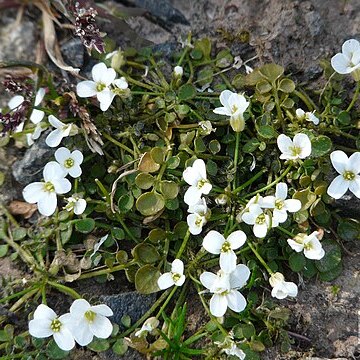Perennial glabrate to pilose slender herb, with rather stout branched stock, stems decumbent to ascending, up to 10 cm. long, very slender, somewhat flexuose. Lvs scattered, few, on slender to filiform petioles up to 3 cm. or more long, simple to trifoliolate, rarely with a further pair of minute pinnules; terminal lflt broad-ovate to suborbicular, cordate to broad-cuneate at base, up to c. 1 cm. × 7·5 mm., shallowly lobed· to entire. Aerial fls solitary to clustered or corymbosely arranged, on slender pedicels c. 3-4 cm. long; sepals oblong, up to 2 mm. long; petals white, obovate, up to c. 3 mm. long, rarely obsolescent, shortly clawed. Siliques 1-2 cm. × 1-1·5 mm.; style hardly 1mm. long. Subterranean cleistogamic fls apetalous, solitary, on recurved peduncles; sepals minute; stamens minute, 1 to 4; siliques conical, c. 3-5 mm. long, curved; seeds 1-6.
Small annual or possibly perennial herb, hirsute to almost glabrous; stems less than 3 cm long, sometimes stoloniferous. Leaves rosulate, reniform to spathulate to long, entire, rarely with 1 or 2 pairs of tiny lobes, petiolate, Flowers solitary; peduncles c. 1 cm long. Sepals 1–2 mm long, sometimes purple pigmented with white margins, hirsute. Petals 3–3.5 mm long, white. Stamens 4. Style less than 1 mm long. Siliqua linear, c. 1 cm long, c. 1 mm wide, erect. Seeds ovoid to oblong, 1 mm long, compressed.

